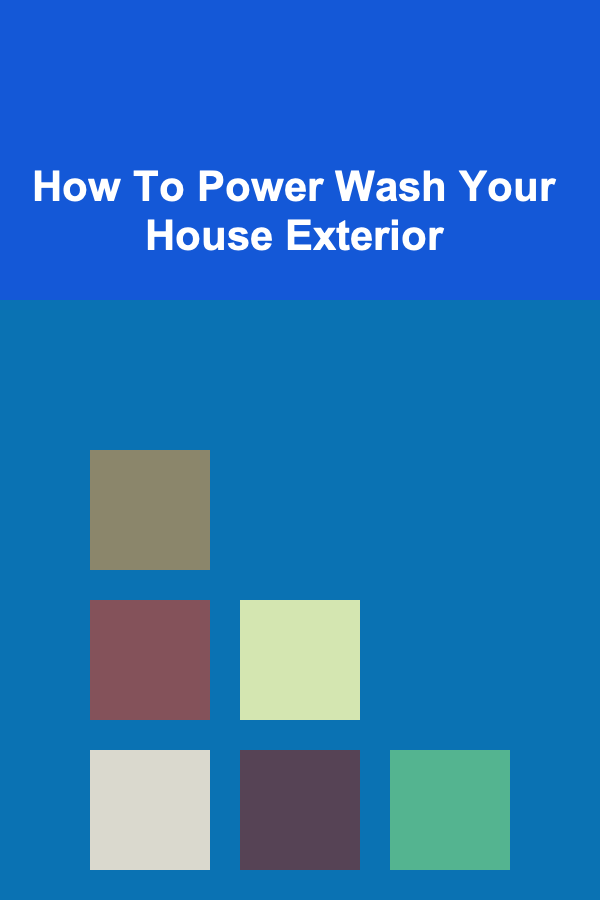
How To Power Wash Your House Exterior
ebook include PDF & Audio bundle (Micro Guide)
$12.99$10.99
Limited Time Offer! Order within the next:

Power washing, also known as pressure washing, is a great way to give the exterior of your house a fresh, clean look. Over time, dirt, grime, mold, and mildew can build up on your home's surfaces, making it look older than it is. Power washing is a fast and efficient way to remove these unsightly stains and restore your home's curb appeal. However, the process requires careful planning and the right technique to avoid damage. In this comprehensive guide, we'll walk you through everything you need to know about how to power wash your house exterior safely and effectively.
Understanding Power Washing
Before diving into the process, it's important to understand what power washing is and how it works. Power washing uses high-pressure water streams to clean surfaces. The pressure can be adjusted to meet the requirements of the surface you're cleaning, making it versatile enough for a variety of materials, such as vinyl siding, wood, brick, and concrete.
Difference Between Power Washing and Pressure Washing
While the terms "power washing" and "pressure washing" are often used interchangeably, there is a subtle difference. Power washing uses heated water, while pressure washing uses regular, cold water. The heated water in power washing can be more effective in loosening dirt, grime, and oil stains. However, both methods rely on high pressure to clean surfaces, making them both powerful tools for cleaning your home.
Why Power Washing Is Important
Power washing can help maintain the aesthetics and integrity of your home. Here are some key reasons why it's beneficial:
- Enhanced Curb Appeal: A clean exterior can make a huge difference in how your house looks from the street. Whether you're preparing to sell your home or just want it to look its best, power washing removes dirt and grime that detract from its appearance.
- Prevent Damage: Over time, algae, mold, and mildew can grow on your home's exterior, especially in areas with high humidity. These growths can cause significant damage to surfaces if left unchecked. Power washing helps to remove these harmful organisms before they cause long-term issues.
- Improved Longevity: Regular maintenance with power washing helps preserve the integrity of your home's materials. It can prevent the buildup of corrosive substances, which can weaken surfaces like wood, siding, and concrete.
- Health and Safety: Mold and mildew can not only affect the aesthetic of your home but can also cause health problems for the residents. Cleaning them off with a power washer reduces the risk of respiratory issues, allergies, and other health concerns.
Preparing for Power Washing
Power washing might seem like a simple task, but proper preparation is key to achieving the best results without causing damage. Here's how to prepare for the job:
1. Choose the Right Equipment
When selecting a power washer, make sure to choose one that is appropriate for the size of your home and the type of surface you will be cleaning. The power washer should have adjustable pressure settings to prevent damage to delicate surfaces. If you don't own a power washer, many hardware stores and rental shops offer them for rent.
- Pressure: The pressure is measured in PSI (pounds per square inch). For most residential applications, a pressure of 1,500 to 3,000 PSI is sufficient. If you're cleaning delicate surfaces, lower pressure is ideal. Higher pressure is better for tough surfaces like concrete and brick.
- Flow Rate: The flow rate, measured in GPM (gallons per minute), indicates how much water the machine uses. A higher flow rate means the machine will be able to cover a larger surface area more quickly.
- Nozzles: Power washers come with different nozzles that vary in size and angle. Narrow nozzles create high-pressure streams, while wider nozzles provide a gentler spray. Make sure to use the appropriate nozzle for the surface you're cleaning.
2. Check the Weather
Ideally, you should power wash your home on a dry, mild day. Excess moisture in the air can affect the efficiency of the cleaning process and prolong the drying time. Avoid cleaning your house when it's windy or raining, as this can lead to uneven results and water streaks.
3. Protect Your Plants and Landscaping
Pressure washing involves a lot of water, which can harm plants, grass, and other landscaping features. Before you start, cover any nearby plants with plastic sheeting or a tarp to shield them from the high-pressure water and cleaning solutions. You should also consider using a low-pressure nozzle to avoid damaging your landscaping.
4. Clear the Area
Ensure the area surrounding your home is free of any obstacles, such as furniture, lawn ornaments, or outdoor equipment. Power washing involves a lot of water and can create a mess, so make sure everything is out of the way to avoid damage and allow for a smoother cleaning process.
5. Safety Gear
Always wear protective gear when power washing. This includes safety goggles to protect your eyes from debris and water, non-slip shoes to avoid slipping on wet surfaces, and long sleeves and pants to shield your skin from high-pressure water.
Step-by-Step Guide to Power Washing Your House Exterior
Now that you've prepared everything, it's time to begin power washing your home's exterior. Follow these steps to ensure the best results:
1. Set Up the Power Washer
Start by setting up your power washer. Attach the appropriate nozzle, connect the water supply, and ensure the power washer is properly plugged in or fueled (depending on the model). Make sure there are no leaks in the hoses.
2. Start from the Top
To avoid streaking and water marks, always begin power washing from the top of the surface and work your way down. This ensures that any dirt and grime are washed away as you move down the wall, rather than splashing up onto clean areas.
Hold the nozzle about 2-3 feet from the surface and begin spraying in a sweeping motion. Be sure to maintain a consistent distance to avoid damaging the surface. If necessary, adjust the pressure according to the type of material you are cleaning.
3. Use Steady, Overlapping Sweeps
As you work your way down the surface, use steady, overlapping sweeps to ensure an even clean. Avoid focusing on one spot for too long, as this can cause damage to the surface. Keep the nozzle moving in a horizontal motion, starting at the top and moving downward.
4. Focus on Stubborn Areas
For tough stains or areas with significant buildup, apply a cleaning solution to help break down the grime. Many power washers come with detergent dispensers, or you can apply a cleaning solution using a pump sprayer. Let the solution sit for a few minutes, then gently scrub the area with a soft brush before power washing it away.
5. Rinse Thoroughly
After you've finished power washing an area, rinse it thoroughly with water to remove any remaining cleaning solution or debris. Make sure there is no residue left on the surface, as it can cause staining or discoloration.
6. Check for Missed Spots
Once you've cleaned the entire surface, step back and inspect your work. Look for any missed spots or areas that might need a second pass. Power washing may not always remove all stains on the first try, especially if they're deeply embedded.
7. Dry the Surface
Once you've finished power washing, allow the surface to dry completely. This may take several hours, depending on the weather conditions and the material you've cleaned.
Post-Cleaning Care and Maintenance
After you've power washed your home, there are a few steps you can take to ensure its long-term cleanliness and condition:
- Seal the Surface: Consider applying a sealant to surfaces like wood, brick, or stone. This provides an extra layer of protection against the elements and helps maintain the clean appearance of your home.
- Routine Maintenance: Power washing should be part of your regular home maintenance routine. Aim to power wash your home's exterior at least once a year to keep it looking its best.
- Check for Damage: While power washing is generally safe, it can expose underlying issues. Look for cracks, loose siding, or other problems that may need attention.
Conclusion
Power washing is an effective way to maintain your home's exterior and improve its appearance. By understanding the equipment, preparation, and technique involved, you can clean your house safely and efficiently. Whether you're getting ready to sell your home or just want to give it a fresh look, power washing can help bring back its beauty. Just remember to follow the steps carefully, use the right tools, and always prioritize safety to ensure the best results.

How to Clean Your Air Vents and Improve Indoor Air Quality
Read More
How to Leverage PESTLE Analysis in Your Market Research
Read More
How to Manage Your Time While Pursuing Hobbies
Read More
How To Use Inkscape for Free Vector Graphics
Read More
Creating a Robust Note-Taking System: A Comprehensive Guide
Read More
How to Balance Your Macronutrients for Optimal Energy
Read MoreOther Products

How to Clean Your Air Vents and Improve Indoor Air Quality
Read More
How to Leverage PESTLE Analysis in Your Market Research
Read More
How to Manage Your Time While Pursuing Hobbies
Read More
How To Use Inkscape for Free Vector Graphics
Read More
Creating a Robust Note-Taking System: A Comprehensive Guide
Read More